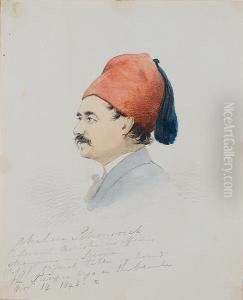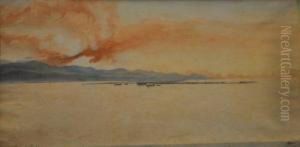Godfrey Thomas Vigne Paintings
Godfrey Thomas Vigne was an English amateur cricketer and explorer, born in 1801 in Worplesdon, Surrey. Although not primarily remembered as an artist, Vigne made significant contributions to the understanding of Central and South Asia through his extensive travels and writings in the early 19th century. He was educated at Harrow School and later attended Oriel College, Oxford, though he left without obtaining a degree. Vigne's passion for exploration was evident early in his life, and he chose to explore regions that were largely unknown to the Europeans of his time.
After leaving Oxford, Vigne embarked on a series of travels that would take him through the Middle East, and extensively through the territories of what is now Pakistan, Afghanistan, and India between 1832 and 1836. His journeys were among the first detailed European accounts of these areas, providing valuable geographic, cultural, and historical insights. Vigne was particularly fascinated with the regions of Kashmir and Ladakh, about which he wrote extensively.
His most notable work, 'Travels in Kashmir, Ladakh, Iskardo, the Countries Adjoining the Mountain-Course of the Indus, and the Himalaya, North of the Panjab,' was published in 1842. This comprehensive account was one of the earliest detailed European observations of these regions, offering insights into the geography, local politics, and cultures. Vigne's works were valuable not only for their geographical and cultural content but also for the detailed illustrations and maps he provided, based on his observations and sketches during his travels.
Despite his contributions to exploration and understanding of Central and South Asia, Vigne's name is not as widely recognized today as some of his contemporaries. After returning to England, he continued to engage in his passion for cricket, a sport in which he had been active since his youth. He played first-class cricket for various teams, including the Marylebone Cricket Club (MCC).
Vigne's health declined in his later years, and he passed away in 1863. His legacy, though not primarily artistic in the traditional sense, lies in his extensive writings and the sketches that accompanied his explorations. These works remain a valuable resource for historians and geographers interested in the early European perspectives on South and Central Asia.


